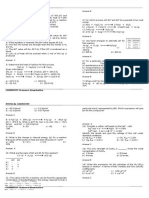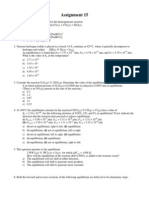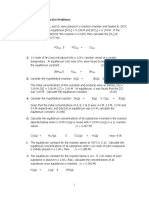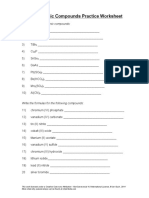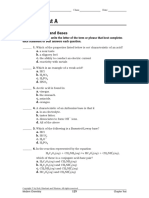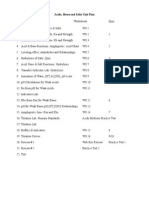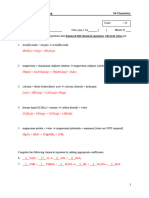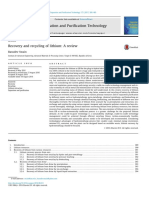Buffers&titrationsquestions Review
Buffers&titrationsquestions Review
Uploaded by
api-279595789Copyright:
Available Formats
Buffers&titrationsquestions Review
Buffers&titrationsquestions Review
Uploaded by
api-279595789Original Title
Copyright
Available Formats
Share this document
Did you find this document useful?
Is this content inappropriate?
Copyright:
Available Formats
Buffers&titrationsquestions Review
Buffers&titrationsquestions Review
Uploaded by
api-279595789Copyright:
Available Formats
1
Aqueous Equilibria:
Buffers & Titrations
AMHS AP Chemistry
Multiple Choice questions
Name__________________
Common-Ion Effect
1) The pH of a solution that contains 0.818 M acetic acid (Ka = 1.77x10-5) and 0.172 M sodium acetate is ___.
A) 4.077
B) 5.434
C) 8.571
D) 8.370
E) 9.922
2) Calculate the pH of a solution prepared by dissolving 0.37 mol of formic acid (HCO2H) and 0.23 mol of
sodium formate (NaCO2H) in water sufficient to yield 1.00 L of solution. The Ka of formic acid is 1.77x104.
A) 2.1
B) 10.46
C) 3.55
D) 2.31
E) 3.95
3) Calculate the pH of a solution prepared by dissolving 0.25 mol of benzoic acid (C7H5O2H) and 0.15 of
sodium benzoate (NaC7H5O2) in water sufficient to yield 1.00 L of solution. The Ka of benzoic acid is 6.50x10-5.
A) 4.41 B) 2.40
C) 3.97
D) 10.08
E) 4.19
4) Calculate the pH of a solution prepared by dissolving 0.15 mol of benzoic acid (HBz) and 0.30 mol of sodium
benzoate in water sufficient to yield 1.00L of solution. The Ka of benzoic acid is 6.50x10-5.
A) 2.52
B) 3.89
C) 4.49
D) 10.16
E) 4.20
5) Calculate the pH of a solution prepared by dissolving 0.750 mol of NH3 and 0.250 mol of NH4Cl in water
sufficient to yield 1.00 L of solution. The Kb of ammonia is 1.77x10-5.
A) 5.22
B) 4.27
C) 9.73
D) 8.78
E) 0.89
6) The pH of a solution prepared by dissolving 0.350 mol of solid methylamine hydrochloride (CH3NH3Cl) in
1.00L of 1.10M methylamine (CH3NH2) is __________. The Kb for methylamine is 4.4 x 10-4. (Assume the final
volume is 1.00 L.)
A) 1.86
B) 2.66
C) 10.15
D) 11.14
E) 10.64
Buffers
7) What does a buffer do?
a) Keeps the pH of a solution constant
b) Keeps the salt concentration of a solution constant
c) Keeps the cation concentration constant
d) Keeps the anion concentration constant
8) What substances are present in a buffer?
a) A weak base or acid and its salt
b) A hydrolyzing salt only
c) A weak base or acid only
d) A salt only
9) The addition of hydrofluoric acid and __________ to water produces a buffer solution.
C) NaF
D) NaCl
E) NaBr
A) HCl B) NaNO3
40) A 25.0 mL sample of 0.723 M HClO4 is titrated with a 0.273 M KOH solution. What is the [H+] (molarity)
before any base is added?
A) 0.439
B) 1.00 x 10-7
C) 0.723
D) 2.81 X 10-13
E) 0.273
41) A 25.0 mL sample of 0.723 M formic acid is titrated with a 0.273 M KOH solution.
The Ka of formic acid is 1.77 x 10-4. What is the pH of the acid before any base is added?
A) 0.14
B ) 1.95
C) 3.89
D) 7.00
E) 8.19
42) A 25.0 mL sample of 0.22 M hydrazoic acid (HN3 ; Ka = 2.6 x 10-5) is titrated with a 0.30 M KOH solution.
What is the pH of the solution before any base is added?
A) 2.62
B) 5.42
C) 7.00
D) 8.97
E) 11.22
43) The pH of a solution prepared by mixing 50.0 mL of 0.125 M KOH and 50.0 mL of 0.125 M HCl is ______.
A) 6.29
B) 7.00
C) 8.11
D) 5.78
E) 0.00
44) What is the pH of a solution resulting from 65 mL of 0.15 M HClO3 titrated with 45 mL of 0.18 M NaOH?
A) 0.65
B) 1.45
C) 1.82
D) 7.95
E) 8.21
45) A 25.0 mL sample of 0.22 M hydrazoic acid (HN3 ; Ka = 2.6 x 10-5) is titrated with a 0.30 M KOH solution.
What is the pH of the solution after 16.0 mL of base is added?
A) 2.62
B) 5.42
C) 7.00
D) 8.97
E) 11.22
46) A 25.0 mL sample of 0.800 M HClO4 is titrated with a 0.300 M KOH solution. The H3O+ concentration after
the addition of 10.0 mL of KOH is __________ M.
A) 0.486
B) 1.00 x 10-7
C) 0.723
D) 2.81 X 10-13
E) 0.273
47) A 30.0 mL sample of 0.50 M HClO4 is titrated with a 0.25 M KOH solution. The H3O+ concentration after
the addition of 5.0 mL of KOH is __________ M.
A) 0.00125
B) 0.0138
C) 0.0150
D) 0.393
E) 0.439
48) A 30.0 mL sample of 0.72 M HClO4 is titrated with a 0.27 M KOH solution. What is the H3O+ concentration
after the addition of 80.0 mL of KOH?
A) 1.00 x 10-7
B) 0.0216
C) 0.196
D) 0.27
E) 0.72
49) What volume (mL) of 0.5M HNO3 is necessary to titrate 25 mL of 0.05M KOH solution to the endpoint?
A) 2.5
B) 5.0
C) 10
D) 25
E) 50
50) What volume (mL) of 0.5M HNO3 is necessary to titrate 25 mL of 0.05M Ca(OH)2 solution to the endpoint?
A) 2.5
B) 5.0
C) 10
D) 25
E) 50
51) How much 1.5 M NaOH is necessary to exactly neutralize 20.0 mL of 2.5 M H3PO4?
A) 20
B) 33
C) 40
D) 60
E) 100
52) A 25.0 mL sample of an HCl solution is titrated with a 0.15 M NaOH solution. The equivalence point is
reached with 75.0 mL of base. The concentration of HCl is _________ M.
A) 11.7
B) 0.00214
C) 0.450
D) 0.267
E) 0.139
53) A 50.0 mL sample of an aqueous H2SO4 solution is titrated with a 0.100 M NaOH solution. The equivalence
point is reached with 100 mL of NaOH solution. The concentration of H2SO4 is __________ M.
A) 0.050
B) 0.100
C) 0.150
D) 0.200
E) 0.400
18) The point at which the moles of the added strong base are equal to the moles of the weak acid
initially present
19) The point at which the pH is closest to that of the strong base being added
20) The point at which the concentrations of the weak acid and its conjugate base are approximately
equal
The graph below shows the titration curve that results when 100 ml of 0.25M acetic acid is titrated
with 0.10M NaOH. Answer questions 27-29 is based on the curve below.
10
21) Which of the following indicators is the best choice for this titration?
Indicator
pH range of colors
A) methyl orange
3.2-4.4
B) Methyl red
4.8-6.0
C) Bromothymol blue
6.1-7.6
D) Phenolphthalein
8.2-10.0
E) Alizarin
11.2-12.4
22) What part of the curve corresponds to the optimum buffer action of the acetic acid /acetate ion
pair?
A) point D
D) all along the section BD
B) point A
E) all along the section DE
C) Point E
23) What is the volume of the base used at the end point?
A) 14mL
B) 22mL
C) 25mL
D) 27mL
E) 40mL
14
Buffers and Titration Free response HW
PSI AP Chemistry
Name------------------------------Write the completed balanced equation for the following reactions:
1) H2SO4 + Al(OH)3
1) HCl+ Mg(OH)2
2) H3PO4 + Ca(OH)2
3) HNO3 + NH4OH
4) Calculate the concentration of hydrochloric acid if 30 ml of this acid is neutralized by 40 ml of
0.010M sodium hydroxide.
5) Calculate the concentration of sulfuric acid if 60.0 ml of this acid is neutralized by 10.0 ml of
0.010M sodium hydroxide.
6) What volume of 0.3M H2SO4 is required to titrate 90 ml of 0.4M NaOH to the end point?
7) How many ml of water needs to be added to make 500ml of 3M HCl from a stock solution of
250mL of the acid which is 6M ?
8) Predict the following salt solutions will be acidic, basic or neutral. Also fill in the rest of the table
regarding the parent acid and base from which they were formed.
Salt
Parent acid
Parent base
Type of solution
(Basic or acidic)
KCl
NH4NO3
Na3PO4
NH4 F
CuI2
SrSO4
Li(CH3COO)
Ba3(PO4)2
Ka of HF = 3.5 x 10-4,
Kb of NH3 = 1.8x 10-5
Free response
1) The overall dissociation of oxalic acid, H2C2O4, is represented below. The overall dissociation
constant is also indicated.
H2C2O4 2 H+ + H2C2O42K = 3.78 x 10-6
15
(a)
What volume of 0.400-molar NaOH is required to neutralize completely a 5.00 x 10-3 mole
sample of pure oxalic acid?
(b)
Give the equations representing the first and second dissociations of oxalic acid.
Calculate the value of the first dissociation constant, K1, for oxalic acid if the value of the second
dissociation constant, K2, is 6.40 x 10-5.
(c)
To a 0.015-molar solution of oxalic acid, a strong acid is added until the pH is 0.5. Calculate
the [C2O42-] in the resulting solution. (Assume the change in volume is negligible.)
(d)
Calculate the value of the equilibrium constant, Kb, for the reaction that occurs when solid
Na2C2O4 is dissolved in water.
2) A buffer solution contains 0.40 mole of formic acid, HCOOH, and 0.60 mole of sodium formate,
HCOONa, in 1.00 liter of solution. The ionization constant, Ka, of formic acid is 1.8x10-4.
(a)
Calculate the pH of this solution.
(b)
If 100 milliliters of this buffer solution is diluted to a volume of 1.00 liter with pure water, the pH
does not change. Discuss why the pH remains constant on dilution.
(c)
A 5.00 milliliter sample of 1.00 molar HCl is added to 100 milliliters of the original buffer
solution. Calculate the [H3O+] of the resulting solution.
(d)
A 800 milliliter sample of 2.00-molar formic acid is mixed with 200 milliliters of 4.80-molar
NaOH. Calculate the [H3O+] of the resulting solution.
3) A volume of 30.0 ml of 0.10M NH3 is titrated with 0.20M HCl. The value of the base dissociation
constant, Kb for NH3 in water is 1.8x10-5.
(a) Write the net ionic equation for the reaction of NH3 with HCl
(b) Using the axes provided below, sketch the titration curve that results when a total of 40ml of
0.20M HCl is added drop wise to the 30ml volume of 0.10M NH3
(c) From the table below, select the most appropriate indicator for the titration. Justify your answer.
Methyl red
Bromothymol blue
Phenolphalein
5.5
7.1
8.7
You might also like
- Stoichiometry AP Exam QuestionsDocument12 pagesStoichiometry AP Exam QuestionsAllen Jerry AriesNo ratings yet
- CHM 2210 Practice Exam 1Document12 pagesCHM 2210 Practice Exam 1Shaima MossamatNo ratings yet
- Koleksi Eksperimen Biologi SPMDocument39 pagesKoleksi Eksperimen Biologi SPMNorhaida Shahadan100% (2)
- AP Chem CH 15 Practice QuizDocument8 pagesAP Chem CH 15 Practice QuizHussain MerchantNo ratings yet
- CHEM 1412. Chapter 17. Acid-Base Equilibria - Homework - Ky PDFDocument20 pagesCHEM 1412. Chapter 17. Acid-Base Equilibria - Homework - Ky PDFDi Vlad PeÑa PrietoNo ratings yet
- واجب شامل للمقررDocument30 pagesواجب شامل للمقررOsama AlkinaneNo ratings yet
- Unit 5 Practice Test Multiple ChoiceDocument10 pagesUnit 5 Practice Test Multiple ChoiceMadhavan Vijay100% (1)
- Gas Stoichiometry WSDocument2 pagesGas Stoichiometry WSRogerine RoyNo ratings yet
- All Year Chemistry Up To 2018 PDFDocument37 pagesAll Year Chemistry Up To 2018 PDFAGAH LUCKYNo ratings yet
- Test BanksDocument21 pagesTest Banksalex_flutistNo ratings yet
- JRS PhyChemDocument13 pagesJRS PhyChemsalazarjoelNo ratings yet
- Test2 Ch17a Acid-Base Practice Problems PDFDocument12 pagesTest2 Ch17a Acid-Base Practice Problems PDFRaphael CastilloNo ratings yet
- Assignment 151Document5 pagesAssignment 151Hai Xuan DoNo ratings yet
- Class Test 1: Section A (Multiple-Choice Questions)Document10 pagesClass Test 1: Section A (Multiple-Choice Questions)Kgaugelo TraciaNo ratings yet
- Problems ElectrochemistryDocument11 pagesProblems ElectrochemistryorlandompsilvaNo ratings yet
- Redox Review With ANSWERS - 4Document13 pagesRedox Review With ANSWERS - 4AYESHA NAAZNo ratings yet
- Acid Base Concepts (Quiz With Answers)Document12 pagesAcid Base Concepts (Quiz With Answers)heylinssNo ratings yet
- Electrolysis Worksheet 2Document11 pagesElectrolysis Worksheet 2Menaga A/P IlangkovanNo ratings yet
- Equilibrium Extra PracticeDocument14 pagesEquilibrium Extra PracticeAshley KrakowerNo ratings yet
- Concentration Calcs With AnswersDocument6 pagesConcentration Calcs With AnswersKhadija Karim0% (1)
- Molarity WorksheetDocument3 pagesMolarity WorksheetKhloud MadihNo ratings yet
- Solved Multiple Choice Questions IE by NKB - PDF 116788864Document15 pagesSolved Multiple Choice Questions IE by NKB - PDF 116788864Pranav SharmaNo ratings yet
- Faraday's Law WorksheetDocument4 pagesFaraday's Law WorksheetBrianna MalcolmNo ratings yet
- APEF - Electrochemistry - Multiple Choice Questions - Page 1 of 2Document2 pagesAPEF - Electrochemistry - Multiple Choice Questions - Page 1 of 2alyaa sheirNo ratings yet
- Worksheet 3 (Partial Pressures)Document2 pagesWorksheet 3 (Partial Pressures)Jose Ruben SortoNo ratings yet
- Electrochemistry Multiple ChoicegovtDocument32 pagesElectrochemistry Multiple ChoicegovtLokesh Khobragade100% (3)
- Topic 9 19 MC PracticeDocument18 pagesTopic 9 19 MC PracticeDharmesh Ramnarayan Yadav100% (1)
- The S-Block ElementsDocument51 pagesThe S-Block ElementsDiksha TNo ratings yet
- Using Solubility Rules To Predict Precipitates in ReactionDocument3 pagesUsing Solubility Rules To Predict Precipitates in ReactionRaiel AlvaroNo ratings yet
- Gibbs WorksheetDocument4 pagesGibbs WorksheetDon'tAsK TheStupidOnesNo ratings yet
- Practice Test Acids BasesDocument4 pagesPractice Test Acids Basesdemetri lanezNo ratings yet
- Class XI Chemistry Worksheet 2021Document43 pagesClass XI Chemistry Worksheet 2021Muffadal AlaviNo ratings yet
- Naming Ionic Compounds Practice WorksheetDocument2 pagesNaming Ionic Compounds Practice WorksheetnancyfloryNo ratings yet
- ElectrochemDocument75 pagesElectrochemMhyl HitsuyagamikaelsonNo ratings yet
- Net Ionic Equation W.S. AnswersDocument2 pagesNet Ionic Equation W.S. Answersgimarreyes23No ratings yet
- Test4 ch19 Electrochemistry Practice-answers-MarkedDocument13 pagesTest4 ch19 Electrochemistry Practice-answers-MarkedEga SukmaNo ratings yet
- Test #2: Thermochemistry Multiple Choice: Read Each Question Carefully and Then Select The Letter of The Correct Answer. Circle YourDocument3 pagesTest #2: Thermochemistry Multiple Choice: Read Each Question Carefully and Then Select The Letter of The Correct Answer. Circle YourAidan Kyle SanglayNo ratings yet
- CHE 160 Semester Review Zumdahl CH 5-7Document20 pagesCHE 160 Semester Review Zumdahl CH 5-7Kinal PatelNo ratings yet
- Net Ionic Equations-ProblemsDocument3 pagesNet Ionic Equations-ProblemsChikuta ShingaliliNo ratings yet
- Modern Chemistry Chapter Test :ADocument6 pagesModern Chemistry Chapter Test :ARayan AltamimiNo ratings yet
- Acid-Base Chemistry. Extra Practice Problems General Types/Groups of ProblemsDocument13 pagesAcid-Base Chemistry. Extra Practice Problems General Types/Groups of ProblemsYeabisraNo ratings yet
- Workbook - AcidsDocument132 pagesWorkbook - AcidsAgustina Itin100% (1)
- PLTL Ch. 16 AssignmentDocument6 pagesPLTL Ch. 16 AssignmentJules BrunoNo ratings yet
- Fill in The Table Below:: Empirical Formula WorksheetDocument2 pagesFill in The Table Below:: Empirical Formula WorksheetSherida GibbsNo ratings yet
- Ap Chemistry Lab RubricDocument3 pagesAp Chemistry Lab Rubricapi-258145192No ratings yet
- Grade 12 Chem Final ExamDocument3 pagesGrade 12 Chem Final Examabdimoh7522No ratings yet
- Chemistry Balancing EquationDocument3 pagesChemistry Balancing EquationS3MT-10 Fong Lok ChingNo ratings yet
- Analytical ChemDocument2 pagesAnalytical ChemVaanNo ratings yet
- Chapter 1, Naming CompoundsDocument19 pagesChapter 1, Naming CompoundsKurdishNo ratings yet
- Problem Set On ElectrochemistryDocument2 pagesProblem Set On ElectrochemistryMark Cliffton BadlonNo ratings yet
- Acid Base - Q - MSDocument41 pagesAcid Base - Q - MSAnonymous ANo ratings yet
- Chemistry - Test ElectrochemistryDocument12 pagesChemistry - Test Electrochemistrypolamraju100% (2)
- Section 9.5: Stoichiometry of Solutions: 0.25 Mol / L 0.500 Mol/lDocument16 pagesSection 9.5: Stoichiometry of Solutions: 0.25 Mol / L 0.500 Mol/lrashmi_harryNo ratings yet
- Organic Chem Lab Final ExamDocument7 pagesOrganic Chem Lab Final Exammvmbapple100% (1)
- New QB Acid and Base 1Document24 pagesNew QB Acid and Base 1Irmak CoşkunNo ratings yet
- D and F - Block Elements in NutshellDocument14 pagesD and F - Block Elements in NutshellPrem Mehrotra100% (1)
- Reviewer cm1231p PDFDocument5 pagesReviewer cm1231p PDFPark Shi Win0% (1)
- Acids and BasesDocument7 pagesAcids and Basessmdali14No ratings yet
- Rate Law Worksheet AnswersDocument6 pagesRate Law Worksheet AnswersANGELYN SANTOSNo ratings yet
- Multiple Choice Questions: AMHS AP Chemistry NameDocument22 pagesMultiple Choice Questions: AMHS AP Chemistry NameKZS1996No ratings yet
- 60 Practice Problems For CH 8Document8 pages60 Practice Problems For CH 8СанжарЖеткеневNo ratings yet
- Techno-Economic Analysis of Vanillin ProductionDocument10 pagesTechno-Economic Analysis of Vanillin Productionsuksun.aNo ratings yet
- Final PracticeDocument5 pagesFinal Practicelisbethlc1989No ratings yet
- Nursing Study Guide On BIOCHEMISTRY (CHAPTER 2 WATER)Document10 pagesNursing Study Guide On BIOCHEMISTRY (CHAPTER 2 WATER)Arvin Kim QuibingcoNo ratings yet
- Catalytic Hydrogenation by Using Raney NickelDocument5 pagesCatalytic Hydrogenation by Using Raney NickelSampotterNo ratings yet
- Deterioration of ConcreteDocument6 pagesDeterioration of ConcreteRocky EbrahimNo ratings yet
- EAST AFRICAN STANDARD Synthetic Laundry Detergents For Household Use - SpecificationDocument27 pagesEAST AFRICAN STANDARD Synthetic Laundry Detergents For Household Use - Specificationloay2008No ratings yet
- How To Make RodinalDocument2 pagesHow To Make RodinaltoomuchroseNo ratings yet
- US10995014 Process For Producing Crystallized Metal SulfatesDocument29 pagesUS10995014 Process For Producing Crystallized Metal SulfatesMohamed BuaNo ratings yet
- Section 8 (Amount of Substances)Document7 pagesSection 8 (Amount of Substances)Travel UnlimitedNo ratings yet
- 5070 w05 QP 4Document16 pages5070 w05 QP 4mstudy123456No ratings yet
- Acids and Bases PDFDocument25 pagesAcids and Bases PDFAnonymous Up4OeicsNo ratings yet
- Synthesis of Potassium Tris (Oxalato) Aluminate - Protocol C: H 3 O H 3) .) O C (Al (K 2 O C H 6 KOH 6 Al 2Document4 pagesSynthesis of Potassium Tris (Oxalato) Aluminate - Protocol C: H 3 O H 3) .) O C (Al (K 2 O C H 6 KOH 6 Al 2Ahilya GuptaNo ratings yet
- Revised SS One Third Term NoteDocument130 pagesRevised SS One Third Term Notedarrenn.cpNo ratings yet
- Catholic Junior College H2 Chemistry 9729 2019 Practical Handbook - Part 6Document13 pagesCatholic Junior College H2 Chemistry 9729 2019 Practical Handbook - Part 6Timothy HandokoNo ratings yet
- 03.hydrogen & Its Compounds (Theory) Module-2-1Document8 pages03.hydrogen & Its Compounds (Theory) Module-2-1Raju SinghNo ratings yet
- Sample Paper 5 12thDocument13 pagesSample Paper 5 12thShreya DubeyNo ratings yet
- Cambridge IGCSE: IB22 03 - 0620 - 22/RP © UCLES 2022Document8 pagesCambridge IGCSE: IB22 03 - 0620 - 22/RP © UCLES 2022platosplanetdubaiNo ratings yet
- Atomic Structure and Periodic TableDocument51 pagesAtomic Structure and Periodic TableSoumyaa KumarNo ratings yet
- BS EN 1302 - 1999 Chemicals Used For Treatment of Water Intended For Human Consumption. Aluminium-Based Coagulants. Analytical Methods.Document46 pagesBS EN 1302 - 1999 Chemicals Used For Treatment of Water Intended For Human Consumption. Aluminium-Based Coagulants. Analytical Methods.Денис100% (1)
- Pourbaix Diagrams: Educational MaterialDocument19 pagesPourbaix Diagrams: Educational MaterialRezza Ruzuqi100% (1)
- Design, Qualification, and Validation of Water Systems: July 2018Document15 pagesDesign, Qualification, and Validation of Water Systems: July 2018miftahul jannahNo ratings yet
- 5070 s05 QP 1Document20 pages5070 s05 QP 1Faraz AlamNo ratings yet
- Question PapaerDocument31 pagesQuestion PapaerZubair MahboobNo ratings yet
- M4 Check in ActivityDocument2 pagesM4 Check in Activityjelly fishNo ratings yet
- Genchem w2 1Document24 pagesGenchem w2 1MonicDuranNo ratings yet
- Lithium RecoveryDocument16 pagesLithium RecoverynikitaambeNo ratings yet
- Chem 3Document3 pagesChem 3Lovey ChandiNo ratings yet
- Experiment 9 SaponificationDocument6 pagesExperiment 9 Saponificationpatrice green - SteadmanNo ratings yet
- Moles & StoicheometryDocument71 pagesMoles & Stoicheometrynia ainNo ratings yet










